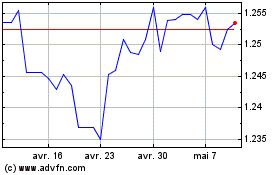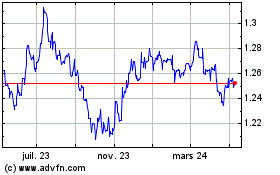Australian Dollar Advances Amid Risk Appetite
20 Juin 2017 - 6:53AM
RTTF2
The Australian dollar climbed against its major rivals in early
European deals on Tuesday amid risk appetite, as European shares
rose following record close on Wall Street overnight, led by a
rebound in technology shares.
Investors are awaiting the decision from index provider MSCI on
whether to include China A-shares in its emerging markets index
after rejecting it on three previous occasions.
Oil prices rose amid mild weakness in the dollar, although
concerns over supply glut kept investors nervous.
Minutes from the Reserve Bank of Australia's June 6 meeting
showed that members of the board observed that the country's rate
of economic growth is expected to continue gradually over the next
few years.
The bank added that the economic outlook, in its current
condition, continues to be supported by low interest rates.
Data from the Australian Bureau of Statistics showed that
Australia's house prices rose 2.2 percent on quarter in the first
three months of 2017.
That was in line with expectations and down from 4.1 percent in
the previous three months.
The aussie showed mixed performance in the Asian session. While
the aussie held steady against the yen and the euro, it rose
against the kiwi. Against the greenback, it fell.
The aussie climbed to 0.7623 against the greenback, following a
decline to a session's low of 0.7585. The next possible resistance
for the aussie-greenback pair is seen around the 0.78 region.
The aussie advanced to 85.07 against the Japanese yen, its
highest since April 3. Continuation of the aussie's uptrend may see
it challenging resistance around the 86.00 area.
The aussie edged up to 1.0075 against the loonie, off its early
low of 1.0027. If the aussie-loonie pair extends rise, 1.02 is
likely seen as its next resistance level.
The aussie firmed to 1.4626 against the euro, a level not seen
since May 3. The aussie is poised to target 1.44 as the next
resistance level.
Figures from the European Central Bank showed that the Eurozone
current account surplus declined to the lowest level in more than
two years in April.
The current account surplus fell to EUR 22.2 billion in April
from EUR 35.7 billion in March. This was the lowest since November
2014, when the surplus totaled EUR 21.65 billion.
The aussie rose back to 1.0502 against the NZ dollar, from a low
of 1.0476 hit at 2:15 am ET. The aussie had earlier set a 4-day
high of 1.0520 in the Asian session. Next likely resistance level
for the aussie is seen around the 1.06 area.
Survey figures from ANZ bank showed that New Zealand's consumer
confidence improved for the second straight month in June.
The ANZ Roy Morgan Consumer Confidence Index rose to 127.8 in
June from 123.9 in May. Moreover, the latest reading was the
highest in five months.
Looking ahead, at 4:45 am ET, the Swiss National Bank Chairman
Thomas Jordan delivers opening remarks at the Swiss International
Finance Forum, in Bern.
In the New York session, U.S. current account for the first
quarter and Canada wholesale sales for April are due.
Dallas Fed President Robert Kaplan speaks about the economy and
monetary policy at the Commonwealth Club in San Francisco at 3:00
pm ET.
Sterling vs US Dollar (FX:GBPUSD)
Graphique Historique de la Devise
De Mar 2024 à Avr 2024

Sterling vs US Dollar (FX:GBPUSD)
Graphique Historique de la Devise
De Avr 2023 à Avr 2024
